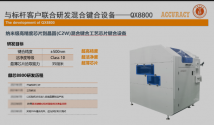A New Era of Hybrid Bonding: Acres releases high-precision Qixin 8800
ecently, at the 11th China Electronic Special Equipment Industry Association Semi-conductor Equipment Annual Conference and Industry Chain Cooperation Forum New Product Launch Conference, Akris grandly launched a nanoscale high-precision hybrid bonding (Hybrid Bonding) equipment - Qixin 8800 . This equipment has become the first successful practice of Acres to advance into semiconductor front-end equipment.
Kirin 8800 is the key core equipment in the chip-to-wafer hybrid bonding (Hybrid Bonding) process, which can bond different types of chips together with higher I/O density and lower interconnection impedance, which is 2.5D The realization of advanced packaging technologies such as encapsulation, 3D encapsulation, and Chiplet provides unprecedented possibilities.

Before Hybrid Bonding, 2D, 2.5D and 3D packages all use solder bumps (solder bump) or micro bumps (Micro bump) to achieve chip and substrate, chip and interposer, chip and chip electrical connection. Hybrid bonding is an advanced stacking technique also known as direct bonding or cold bonding. This technology allows two chips to be directly connected together through metal, without the use of conventional solder or adhesives. It enables denser interconnects, shorter signal paths, and can increase bandwidth, reduce power consumption, and reduce manufacturing costs.
At present, Akris Qixin 8800 has achieved a bonding yield of 95% in the front-end wafer manufacturing line, and is striving to challenge higher bonding accuracy.
With the deceleration of Moore's Law, advanced packaging technology has become the new engine to promote the development of chip performance. BESI, a leading equipment manufacturer in the industry, believes that hybrid bonding technology is the key to the realization of advanced packaging technology, which can provide support for 2.5D/3D integrated architecture. At present, an important reason restricting the development of domestic advanced packaging is that the key equipment of advanced packaging has not yet achieved independent controllability.
Mr. Wang Chi, Chairman of Acres, said at the press conference that advanced packaging is a realistic path for my country's semiconductor industry to achieve cornering overtaking. The R&D and launch of Qixin 8800 is a breakthrough in the huge potential of the advanced packaging field.
With the support of the Jiangsu Provincial Department of Industry and Information Technology's key core technology and equipment research project funds, Akris chip-to-wafer high-precision hybrid bonding equipment has achieved a number of technological breakthroughs at nano-level precision, fully embodying Akris It has profound accumulation, excellent ability and strong determination in insisting on independent research and development capabilities, breaking through international technology blockades, overcoming difficulties, and creating value.
This press conference not only demonstrated the outstanding performance of Qixin 8800, but also highlighted the pioneering spirit of Akris in the cooperation of industry, university, research and application. Mr. Wang Chi introduced the Aike Research Institute to the guests, which is a joint development model and platform for production, education, research and application of Aike Ruisi and customers to jointly tackle key problems. He encouraged more customers to raise technical problems to promote the common progress of the industry. At the same time, he welcomed suppliers and partners to participate in tackling key problems, and jointly apply for projects with universities to provide more outstanding talents for the equipment industry.
This conference brought together more than 380 semiconductor equipment and core component companies, and discussed cutting-edge technologies and industry trends with the theme of "working together to seize opportunities, integrating innovation and manufacturing equipment". The launch of Qixin 8800 will undoubtedly arouse widespread attention inside and outside the industry in the strong atmosphere of the conference.
The release of Qixin 8800 will definitely bring new vitality and impetus to the industry. In the future journey, Acres will always keep its original intention and lead the semiconductor equipment - more accurate, faster and smarter.
